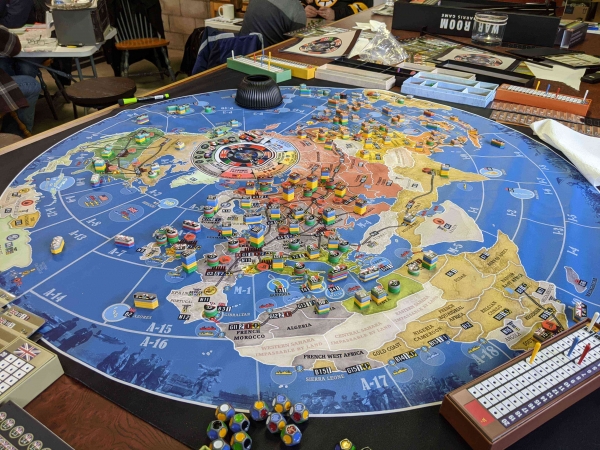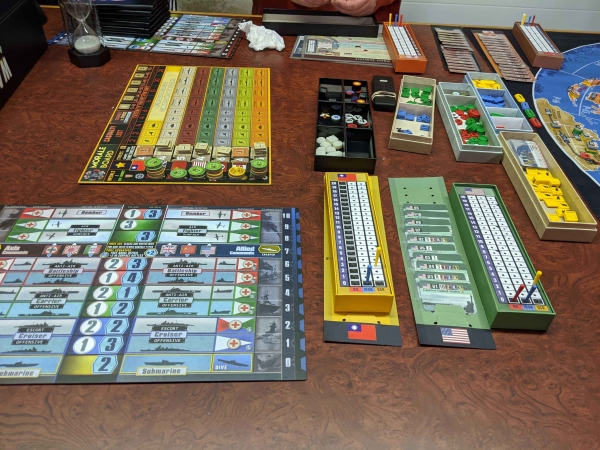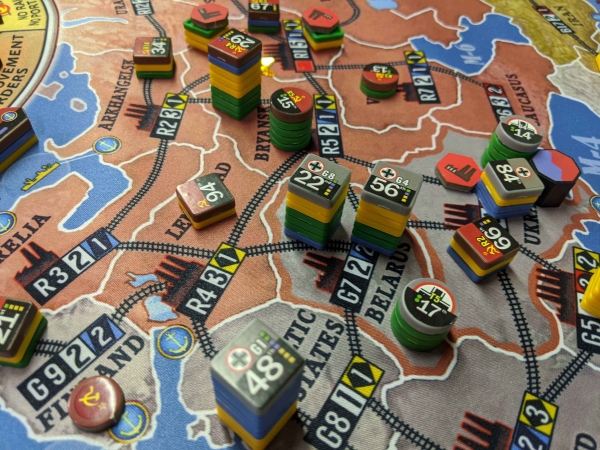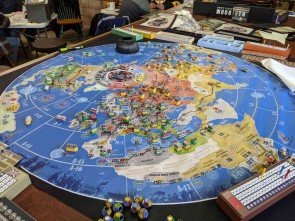Let’s get this out of the way. “You Can’t Fight in Here, This is the War Room.”
There, obligation fulfilled.
If you enjoy Axis and Allies, but wish it had a bit more strategic complexity, then War Room might be your dream come true. War Room comes from the same designer, Larry Harris, and covers much the same ground —World War II, the big picture. War Room is a happy marriage of Axis and Allies’ scope with an emphasis on deeper management of your maneuvers, economy, and morale. The copy I played this past weekend was also a visual treat and tactile delight. This leads to the game’s biggest drawback—all those nifty bits may break some gamers’ budgets.
War Room comes with a few scenarios for differing numbers of players, but I joined in a seven-player global campaign. War Room is designed for two-seven players. The smaller scenarios use fewer nations and only part of the map. We did not complete our game in about 5-6 hours of actual playing time, excluding teaching and lunch, but hope to finish sometime this month. (That’s why this is a First Impressions Review.)
As the global campaign begins, WW2 is already in full swing. Germany has conquered France and a few other countries while launching the invasion of the Soviet Union. Japan is already at war with the U.S. and whittling away at China. Italy is in North Africa, and Great Britain waits with trepidation for a possible German invasion.

Turns in War Room use a fairly standard formula. Each player gets income/resources, consults with allies (all planning—there is no real diplomacy that could cause a change in sides), plans moves and bids for turn order, executes moves, resolves combat, resolves morale and economic issues, purchases new units, and starts again. This is a simplification, as there are several steps to each phase of a turn, but it covers the general flow of the game. The turn structure is not unique. The design is so tight, though, and the bits are so well designed, that War Room moves very smoothly if you just take it step by step. It’s a long game, however, and you will probably want to conduct some phases simultaneously to maintain momentum.
So what makes War Room different?
The components are great and very functional. I played on a very large, round map of the world, printed on a mouse-pad-like material. It was thick and heavy enough to stay in place, even with seven players moving around and reaching across the “board.”

The main bits are the units which make up your forces. The units are stackable plastic pieces, coded by shape and color. All land units are square, air units are round, and naval units are rectangular. Yellow squares are infantry, blue squares are artillery, and green squares are tanks, with similar color schemes for the other arms of service. You stack units of the same shape together to make a force, topping it with an identifying piece of the same shape and marked with your flag and a number unique within your nation’s forces. This is a great solution to the problems of space and stability. A stack of eight pieces (the maximum allowed) plus an identifier takes up A LOT less room than eight plastic tanks/soldiers/guns, and the interlocking pieces has far greater stability than a stack of cardboard counters.
There are also pegboards for tracking resources, battle boards for managing combat, 12-sided dice, pads for planning your moves, cards with info on territories, and a few cylinders and cardboard counters for marking situations on the map (such as a battle in progress or an aircraft mid-flight). The rules are nicely printed with color illustrations.

The planning process is the biggest difference between War Room and Axis and Allies. Using a planning sheet, a player can order up to nine of their nation’s forces to move per turn. Giving orders is simple—write the number of the force and the name of the area you want it to move to. Territory names are printed on the map and pretty intuitive—Berlin is in area G1, for instance. Before moving, everyone takes a few minutes to scheme with their allies. Then everyone writes orders simultaneously.
The trick is that writing orders includes bidding for turn order. Bids are in the form of your most precious resource, oil. The player who bids the most selects their place in the turn order (but everyone in my game was bidding for first). Turn order is important because forces can be pinned by enemy forces moving before yours. A pinned force equals a wasted order that you’ll never get back. Of course, there’s a cost to spending all your oil on turn order. Planes and tanks and ships need oil. Run out and you can’t build any.
The combat system is not revolutionary, but it’s fun. At heart, it’s a bucket of dice—up to 30 per side in sets of 10 (roll 10, resolve 10, then roll more if you can). There are decisions to be made, though. Each side’s units are placed on a battle board, and each unit has a “stance” which you have to decide. Are your tanks set up for offense or defense, or split between them? Defensive tanks and troops roll more dice than offensive tanks and troops but survive more hits. Air units can have more dice for air combat or for ground support—your choice. Submarines can dive and escape a sea battle.
The 12-sided combat dice are printed with dots the same colors as the units, plus black and white dots. In land combat, for each yellow result, you get a hit on an infantry unit. Green hits a tank, and so on. Black dots are wild, and white dots hit any already-wounded unit. But War Room forces you to think about combined arms. If the enemy has more types of units on the battle board than you, you ignore your black and white results and waste those dice.
Finally, there’s stress—on your nation, not on you (hopefully). Lose control of an area and your nation takes stress equal to the area’s strategic value, printed on the map. Lose your capital and take a lot more stress. Lost units cause stress and sometimes make a victory pyrrhic. There’s a board for tracking all of your nation’s stress and, when it hits a certain number, your morale deteriorates. Falling morale has consequences ranging from annoying (lose three resources at the start of each turn) to dire (no rail movement for you, and only six orders) to catastrophic (no more resources for you!). There are also ways to relieve stress—take an enemy territory, buy consumer goods instead of military units—but the stress generally builds faster than the relief if you play aggressively.

Which is why, after conducting a successful invasion of England, my Germans troops were soon marching everywhere on foot instead of taking the train. It turns out holding off a Soviet offensive is difficult when a significant chunk of your ground forces are in England. And let’s not even talk about what happens when the Americans and remaining British come to take England back…
War Room also has simple mechanics to cover key aspects of strategic war, such as raiding convoys and strategic bombing.
In short, War Room is a great evolution of the Axis and Allies style of wargame. It adds enough complexity to make it more interesting strategically, at a cost in (probably, in most cases) a longer playing time.
Whether the game is for you depends on your tolerance for luck and simplified designs. Those battle dice determine a lot, and one good series of enemy rolls can wipe out turns of unit building. One design feature commented on by the British player was that the abstract rules for troop transports probably make invasions easier than they should be (ahem!). But more complex rules could bog the game down, so it’s a matter of taste. Ask yourself: does the luck in beer & pretzels games bother me? How about the sometimes ahistorical mechanics? If you can get past those questions, you should enjoy War Room.
Then there’s the cost, monetarily. War Room is not uniquely expensive in the age of Kickstarters with hundreds of miniatures, but it isn’t on the same cost level as Axis and Allies, either. At this writing, the base game is $240 from the Nightingale Games web site. The jumbo pack of extras, including the mouse-pad map, is another $115. I’m not questioning whether there is enough value in the box(es) to justify the cost. It just seems fair to warn anyone interested in the game that it ain’t cheap. (Full disclosure: the copy I played belongs to someone else.) I suspect the base game is just as enjoyable as the expanded version, since the bonus items are nice but don’t change the rules or mechanics.
I had a grand time learning and playing War Room and look forward to another go at it.
 Games
Games How to resolve AdBlock issue?
How to resolve AdBlock issue? 





























